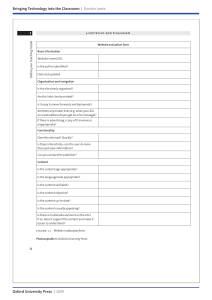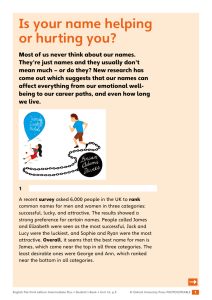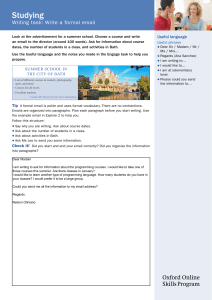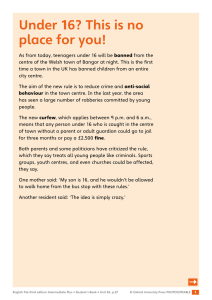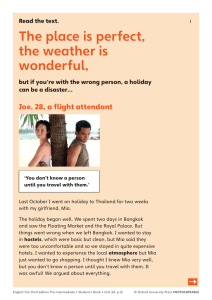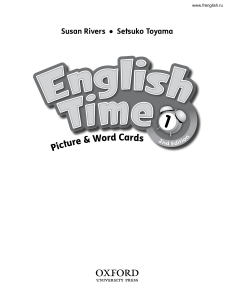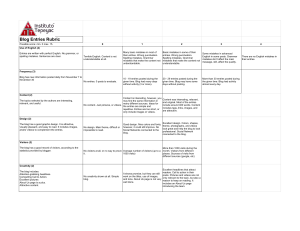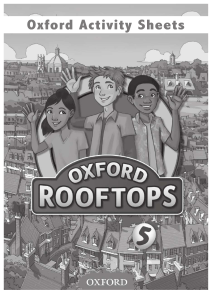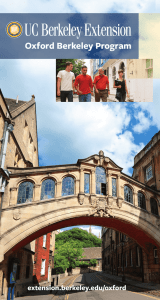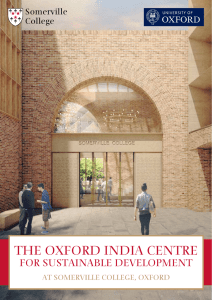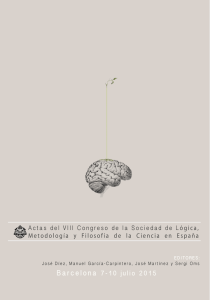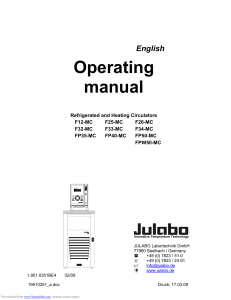England - English Center
Anuncio
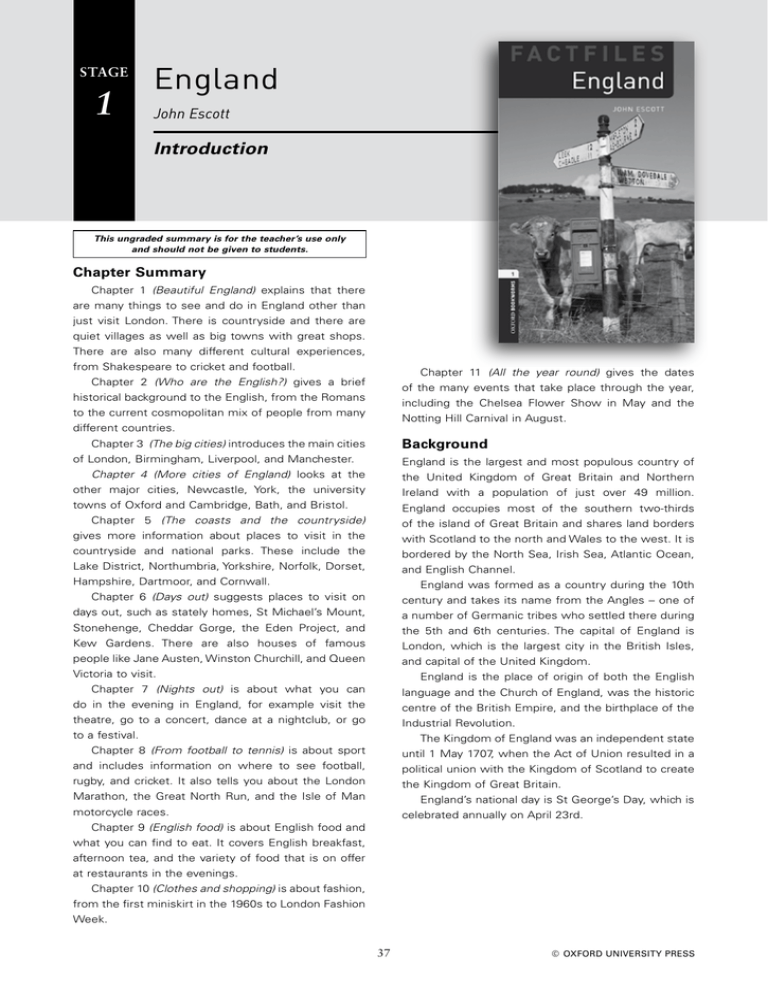
STAGE 1 England John Escott Introduction This ungraded summary is for the teacher’s use only and should not be given to students. Chapter Summary Chapter 1 (Beautiful England) explains that there are many things to see and do in England other than just visit London. There is countryside and there are quiet villages as well as big towns with great shops. There are also many different cultural experiences, from Shakespeare to cricket and football. Chapter 11 (All the year round) gives the dates Chapter 2 (Who are the English?) gives a brief of the many events that take place through the year, historical background to the English, from the Romans including the Chelsea Flower Show in May and the to the current cosmopolitan mix of people from many Notting Hill Carnival in August. different countries. Background Chapter 3 (The big cities) introduces the main cities of London, Birmingham, Liverpool, and Manchester. England is the largest and most populous country of Chapter 4 (More cities of England) looks at the the United Kingdom of Great Britain and Northern other major cities, Newcastle, York, the university Ireland with a population of just over 49 million. towns of Oxford and Cambridge, Bath, and Bristol. England occupies most of the southern two-thirds Chapter 5 (The coasts and the countryside) of the island of Great Britain and shares land borders gives more information about places to visit in the with Scotland to the north and Wales to the west. It is countryside and national parks. These include the bordered by the North Sea, Irish Sea, Atlantic Ocean, Lake District, Northumbria, Yorkshire, Norfolk, Dorset, and English Channel. Hampshire, Dartmoor, and Cornwall. England was formed as a country during the 10th Chapter 6 (Days out) suggests places to visit on century and takes its name from the Angles – one of days out, such as stately homes, St Michael’s Mount, a number of Germanic tribes who settled there during Stonehenge, Cheddar Gorge, the Eden Project, and the 5th and 6th centuries. The capital of England is Kew Gardens. There are also houses of famous London, which is the largest city in the British Isles, people like Jane Austen, Winston Churchill, and Queen and capital of the United Kingdom. Victoria to visit. England is the place of origin of both the English Chapter 7 (Nights out) is about what you can language and the Church of England, was the historic do in the evening in England, for example visit the centre of the British Empire, and the birthplace of the theatre, go to a concert, dance at a nightclub, or go Industrial Revolution. to a festival. The Kingdom of England was an independent state Chapter 8 (From football to tennis) is about sport until 1 May 1707, when the Act of Union resulted in a and includes information on where to see football, political union with the Kingdom of Scotland to create rugby, and cricket. It also tells you about the London the Kingdom of Great Britain. Marathon, the Great North Run, and the Isle of Man England’s national day is St George’s Day, which is motorcycle races. celebrated annually on April 23rd. Chapter 9 (English food) is about English food and what you can find to eat. It covers English breakfast, afternoon tea, and the variety of food that is on offer at restaurants in the evenings. Chapter 10 (Clothes and shopping) is about fashion, from the first miniskirt in the 1960s to London Fashion Week. 37 © OXFORD UNIVERSITY PRESS England STAGE 1 Pre-reading activity Word search Match these words with the definitions below. Use the glossary at the back of England to help you. castle, cheese, coast, countryside, flag, gallery, museum, music, park, plant, queen, show, theatre, tour, university DEFINITIONS 1 a large, stone building _______ 2 the part of the land that is near the sea _______ 3 a building where you go to see plays _______ 4 a place where people go to study after they leave school _______ 5 the most important woman in the country _______ 6 a short visit to see a building or a city _______ 7 land with trees, rivers etc. that is away from towns _______ 8 a piece of cloth with a special pattern on it; every country has one _______ 9 a place where you can look at old or interesting things _______ 10 a place where you can see paintings and other kinds of art _______ 11 something that grows in the ground _______ 12 when you sing or play an instrument, you make _____ 13 yellow or white food made from milk _______ 14 a group of things in one place that people go to see _______ 15 a large place with trees and gardens where you can go to walk, play games etc. _______ Now find the words in the wordsearch below. D E R C O A S T N I P Q F L A G C V D O G I U O M C H E E S E U A D N Z U F K E E F M R A D I O S Q U E E N E R S T V H E I B G A L L E R Y E N U F T H E A T R E T R E M P U L K I O N S A S V C A S T L E B M U S I C R R M G O S H O W Q T L A K U J P L A N T F Y E C O U N T R Y S I D E H To the teacher Aim: To introduce students to some of the key Key: castle, coast, theatre, university, queen, tour, vocabulary countryside, flag, museum, gallery, plant, music, Time: 10–15 minutes. cheese, show, park. PHOTOCOPIABLE © OXFORD UNIVERSITY PRESS 38 STAGE 1 England While reading activity Spot the mistakes Read this summary of Chapter 3 and correct the mistakes. Every week twenty million people come to London to visit St John’s Cathedral, Blenheim Abbey, and the Castle of Parliament. They also visit the Prime Minister’s home at Buckingham Palace. London also has many museums, galleries, theatres, and clubs. Birmingham is England’s biggest city after Liverpool. Today, more than ten million people live there. It was called ‘the workplace of the world’ because people made many things there. Now it is a good place for music, art, and shopping. At the Grand National shopping mall - there are more than 160 shops. Liverpool is next to the River Thames in the south of England. In the 1860s the Beatles lived there. It also has the Big National, a very famous horse race, and the world’s fifth biggest cathedral. Many people left Liverpool between 1830 and 1930 for a new life in different countries. Manchester has one of the most famous tennis clubs in the world and it also has one of Europe’s biggest restaurants – the Trafford Centre. L. S. Lowry was a famous Manchester artist. You can see his art in the beautiful new Lowry building. Now write a summary of Chapter 4, and include five mistakes. When you have finished it, give it to another student to correct. To the teacher Where: After the students have finished reading the summary and correct the mistakes they find. Chapter 4. When they have all finished, check the answers with Aim: To help with summarizing and revision of the whole class. For part two they write their own reading. summary of Chapter 4, with their five deliberate Time: 20–30 minutes mistakes, and give it to a partner. For part three they Organization: You will need a photocopy of the read their partner’s summary and find and correct the worksheet for each student. The activity is in three mistakes. They then return the corrected summary parts, which can be done together in one class or to their partner to check that they found all the separately over two. For part one, the students read mistakes. 39 © OXFORD UNIVERSITY PRESS PHOTOCOPIABLE STAGE 1 England After reading activity Where, when, and what? 1 Can you find these places on the map of England? 5 Bath, Birmingham, Brighton, Bristol, Cambridge, Liverpool, London, Manchester, Newcastle-upon-Tyne, Norwich, Oxford, York 6 4 3 11 2 8 7 1 12 9 2 Where and when did these famous English people live or work, and what did they do? 10 Where did they live or When did they live work? there? 1 2 3 4 5 6 What did they do? Mary Quant Winston Churchill Jane Austen William Wordsworth Charlotte Bronte L. S. Lowry To the teacher Where: After students have finished the book. 3 Liverpool, 4 Manchester, 5 Newcastle-upon-Tyne, 6 Aim: To check if students remember the location York, 7 Oxford. 8 Cambridge, 9 Bath, 10 Brighton, 11 of the key cities in England (Activity 1). To check Norwich, and 12 Bristol. if students know where famous people lived or Activity 2: 1 London, she made the first miniskirt, worked, and what they did (Activity 2). 1960s; 2 Chartwell, near Sevenoaks in Kent, lived Time: 15–20 minutes for both activities. at Chartwell for forty years, Prime Minister at the Organisation: Both activities can be done together, time of the Second World War; 3 Chawton, near or separately. Ask students to fill in the answers Winchester in Hampshire and Bath, Bath 1801 to individually and then check with a partner before 1806, lived at Chawton for eight years, writer; 4 Lake checking with the whole class. They may want to look District, came to Lake District in 1906 and lived there at the map on page 2 to make sure they know where for many years, writer; 5 Haworth in Yorkshire, lived the main towns are. in the Parsonage in Haworth from 1820 to 1855, Key: Activity 1: 1 London, 2 Birmingham, writer; 6 Manchester, 1887 to 1976, artist. PHOTOCOPIABLE © OXFORD UNIVERSITY PRESS 40
